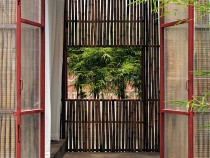
© Hiroyuki Oki
In Vietnam the population is growing, and people in search of employment are moving to the provinces in which the economy is flourishing. Consequently, many of the inhabitants must live in cramped quarters. In the Mekong Delta, housing is particularly scarce for workers whose incomes are small. The prototype was developed with this group in mind. By minimising functions and using low-cost materials and a simple structural system, the architects came up with a building that requires neither machinery nor special techniques. To reduce the construction costs, the future dwellers are encouraged to participate in the construction process. The bathroom and kitchen are situated in a central location outside the unit and shared with several families. Two prototypes were constructed in Dong Nai province, on the construction site of a kindergarten project also designed by Vo Trong Nghia Architects. The smaller of the two, measuring 18 m2, is currently in use as construction-site office; the larger, with a floor area of 22.5 m2, was designed as a model home, demonstrating the flexibility of this prototype.The house has optimised space for living, eating and sleeping. The plan was designed to allow additions along the longitudinal axis. The building skin of the one-room home is polycarbonate sheet; it is mounted on a lightweight steel frame. The interior surfaces and the ceiling are clad in bamboo cane. These materials are all inexpensive, lightweight, and readily available. Ultra-light joists support the cantilevering shed roof. The latter reliably disperses rainwater during the wet season and plays an important role in the ventilation of the dwelling. Air flows in through the facade’s ventilated cavity or through open windows and doors; it then flows back out through the bamboo cane integrated in the ceiling. Thanks to this system, air conditioning is not required.







